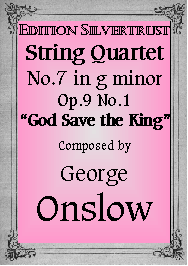Presents
George Onslow
String Quartet No.7 in g minor, Op.9 No.1
"God Save the King"
 George
Onslow's String Quartet No.7, Op.9 No.1 became one of the most famous and
frequently performed quartets during the 19th century. Yet, until a few years
ago, both he and this quartet were virtually unknown to most late 20th century
music lovers.
Perhaps
no composer more than George Onslow (1784-1853) illustrates the fickleness
of fame.
George
Onslow's String Quartet No.7, Op.9 No.1 became one of the most famous and
frequently performed quartets during the 19th century. Yet, until a few years
ago, both he and this quartet were virtually unknown to most late 20th century
music lovers.
Perhaps
no composer more than George Onslow (1784-1853) illustrates the fickleness
of fame.
Onslow was born and lived his entire life in France, the son of an English father and French mother. His 36 string quartets and 34 string quintets were a constant feature of concert programs throughout the 19th century, particularly in Germany, Austria and England. where he was regularly placed in the front rank of composers by such experts as Mendelssohn and Schumann. His work was admired by both Beethoven and Schubert, the latter modeling his own 2 cello quintet (D.956) on those of Onslow and not, as is so often claimed, on those of Boccherini.
String Quartet No.7 was the first
of a set of three, his Opus 9, which collectively were known as the Lord Onslow
Quartets named after his famous grandfather with whom he was quite close and
after whom he had been named. Onslow began work on it immediately upon learning
the of the death of grandfather in 1814. The Quartet opens with an explosive but
not a stormy Allegro. It is the second movement, Andante
religioso, a set of four variations on the national anthem of his
grandfather's country from which the Quartet takes its name. Onslow could quote
the English national anthem without fear of censorship given the fact that in
1814, Napoleon had just been defeated by the Allies, most prominent of whom were
the English. There can be little question that Onslow took the second movement
of Haydn’s Kaiserquartett (Emperor Qt), Op.76 No.3, a similar set of
variations on the then Austrian national anthem (Gott erhalte den Kaiser) as his
model. This movement is the equal, if not actually superior, to Haydn’s right
down to the emotionally somber and organ-like setting of the theme. Of
particular note is the last variation begins with a fugue that has some very
advanced tonalities for the year 1814. This fugue begins softly but gradually
rises to a crescendo of emotion before quietly breaking apart into a bridge
section which returns to a powerful restatement of the theme. (our sound-bite
Presents
the theme and the final variation with the fugue ending before the
restatement) The third movement is a brilliantly haunting syncopated Menuetto
with contrasting trio. The finale, Agitato, begins with an off-beat
drum-like snarl, complete with slinkily downward plunging chromatic passages and
sudden and unanticipated accents.
This quartet should not be missed by either amateur or professional; it certainly belongs in the repertoire and in the concert hall, and stands in stark contrast to anything being composed at this time. Without doubt, a masterpiece of its kind.
Our modern edition is based on the 1817 edition by Steiner of Vienna, but has been entirely reset, with mistakes corrected and rehearsal numbers added.
Parts: $29.95